By Leen Randell
Updated: Jul 10, 2024
10 Best Herbal Decoctions For Dry Nose

Herbal decoctions for dry nose are a natural remedy that involves steeping herbs in hot water to create a soothing liquid that helps to alleviate dryness, congestion, and discomfort associated with nasal dryness.
These decoctions work by moisturizing the nasal passages, reducing inflammation, and loosening mucus, providing instant relief from dry, scratchy noses. Examples of herbal decoctions that help with dry nose include peppermint, eucalyptus, and ginger, which can be made into teas or added to warm compresses for maximum benefit.
This natural remedy improves lives by restoring comfort and normal breathing, allowing individuals to enjoy activities without the discomfort of a dry nose.
The following article describes in detail the most important decoctions for dry nose, including medicinal properties, parts of herbs to use, and recipes for preparations.
- 1. Echinacea purpurea
- 2. Althaea officinalis
- 3. Zingiber officinale
- 4. Eucalyptus globulus
- 5. Mentha x piperita
- 6. Thymus vulgaris
- 7. Lavandula angustifolia
- 8. Ulmus rubra
- 9. Sambucus nigra
- 10. Ginkgo biloba
- What is the best combination of herbal decoctions to use for dry nose?
- What ailments similar to dry nose are treated with herbal decoctions?
1. Echinacea purpurea
Purple coneflower decoctions helps with dry nose because of its natural anti-inflammatory properties.
The decoction's active ingredients, such as triterpenoids and phenolic acids, help to reduce nasal inflammation and congestion. This can provide relief from the discomfort and irritation caused by a dry nose, making it easier to breathe and sinus pressure.
Additionally, the decoction may also help to soothe and calm the nasal passages, promoting a healthy respiratory system.
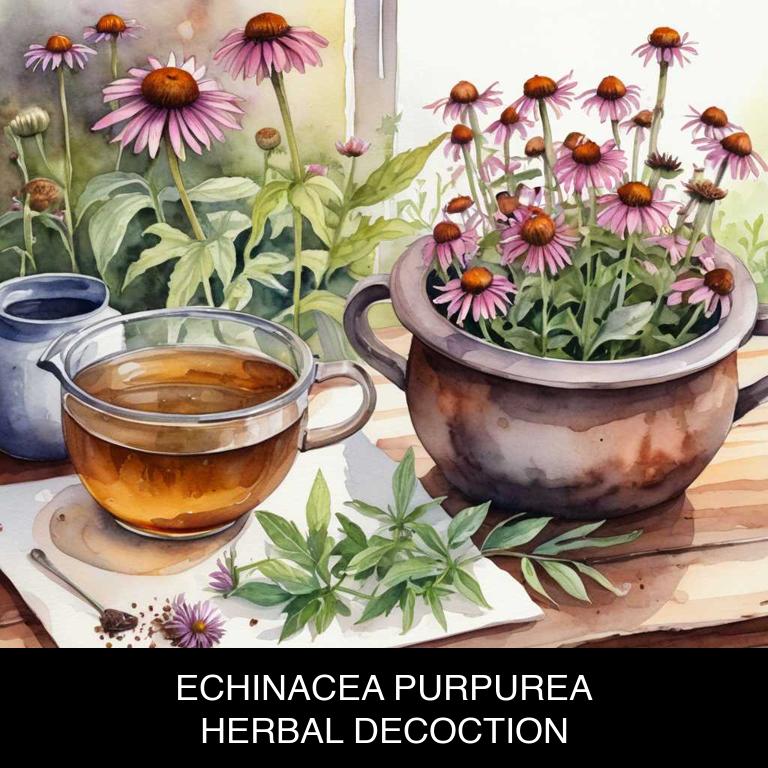
Medicinal Constituents
The list below shows the primary medicinal constituents in Echinacea purpurea decoctions that help with dry nose.
- Iridoid glycosides: These compounds have anti-inflammatory properties, which can help reduce nasal inflammation and alleviate dryness.
- Polyphenolic glycosides: As a potent antioxidant, cichoric acid helps protect the mucous membranes from oxidative damage, promoting a healthy environment and reducing nasal dryness.
- Alkylamides: These compounds have immunomodulatory effects, which can help regulate the immune system's response to allergens and irritants, potentially reducing nasal dryness and inflammation.
Parts Used
The list below shows the primary parts of purple coneflower used to make decoctions for dry nose.
- Roots: They contain the highest concentration of bioactive compounds, including alkaloids and phenolic acids, which help alleviate symptoms of dry nose.
- Flowers: They are rich in flavonoids and phenolic acids, which possess anti-inflammatory and antioxidant properties that aid in soothing dry nose and respiratory issues.
- Leaves: They contain a variety of bioactive compounds, including phenolic acids and alkaloids, which help reduce inflammation and promote healing in the nasal passages.
Quick Recipe
The following recipe gives a procedure to make a basic purple coneflower for dry nose.
- Harvest 1-2 pounds of fresh echinacea purpurea flowers and roots in the summer months.
- Clean the harvested echinacea purpurea flowers and roots with cold running water thoroughly.
- Chop the cleaned echinacea purpurea flowers and roots into small pieces weighing about 1 ounce.
- Steep 1 ounce of chopped echinacea purpurea in 1 quart of boiling water for 5-7 minutes.
- Strain the decoction through a cheesecloth or a coffee filter into a clean container.
2. Althaea officinalis
Marshmallow decoctions helps with dry nose because they contain mucilages, a type of soluble fiber that coats and soothes the nasal passages.
When mixed with water, these mucilages create a protective layer that locks in moisture, providing relief from dryness and irritation.
Additionally, the anti-inflammatory properties of marshmallow root can help to reduce swelling and redness in the nasal tissues, further alleviating discomfort associated with dry nose.

Medicinal Constituents
The list below shows the primary medicinal constituents in Althaea officinalis decoctions that help with dry nose.
- Mucilages: Help with dry nose by forming a protective barrier on the mucous membranes, trapping moisture, and soothing irritation.
- Glycoproteins: Assist in maintaining a healthy balance of moisture in the nasal passages by binding to water and preventing excessive evaporation.
- Flavonoids: Exhibit anti-inflammatory properties that reduce swelling and inflammation in the nasal passages, thereby alleviating dryness and discomfort.
Parts Used
The list below shows the primary parts of marshmallow used to make decoctions for dry nose.
- Roots: They contain mucilages, which are used to soothe and moisturize the nasal passages, relieving dryness and discomfort.
- Leaves: The leaves are rich in flavonoids and other compounds that have anti-inflammatory properties, helping to reduce nasal inflammation and promote healing.
- Roots: The roots are also a good source of antioxidants, which help protect the nasal passages from damage and promote overall health.
Quick Recipe
The following recipe gives a procedure to make a basic marshmallow for dry nose.
- Harvest 20-30 grams of dried root of althaea officinalis from a trusted supplier.
- Rinse the dried root under cold running water for 2 minutes to remove impurities.
- Combine the rinsed root with 500 milliliters of boiling water in a heat-resistant container.
- Steep the mixture for 5-7 minutes to allow the active ingredients to infuse into the water.
- Strain the decoction through a cheesecloth or a fine-mesh sieve into a clean container.
3. Zingiber officinale
Ginger decoctions helps with dry nose because of its natural anti-inflammatory properties that soothe and moisturize the nasal passages.
The decoction's warm, steamy vapors help to loosen and clear out mucus, reducing congestion and relieving dryness. Additionally, ginger's natural antibacterial properties help to combat any underlying infections that may be contributing to the dryness.
By drinking a warm cup of ginger decoction, individuals can experience immediate relief from dry nose symptoms, breathing easier and feeling more comfortable throughout the day.

Medicinal Constituents
The list below shows the primary medicinal constituents in Zingiber officinale decoctions that help with dry nose.
- 6-gingerol: 6-Gingerol has anti-inflammatory properties that help to reduce swelling and irritation in the nasal passages, providing relief from dry nose symptoms.
- Shogaol: Shogaol exhibits expectorant properties, which help to loosen and clear mucus from the nasal passages, making it easier to breathe and reducing dryness.
- Zingiberene: Zingiberene has a warming effect on the body, which can help to increase blood flow to the nasal passages, reducing dryness and congestion.
Parts Used
The list below shows the primary parts of ginger used to make decoctions for dry nose.
- Rhyzomes: Rhyzomes are the most commonly used part due to their high concentration of active compounds that help to warm and moisturize the nasal passages.
- Roots: Roots of Zingiber officinale are also used to make decoctions, as they contain similar properties to the rhyzomes, helping to relieve dryness and congestion.
- Buds: Buds of Zingiber officinale are sometimes used, as they contain a high concentration of essential oils that can help to warm and soothe the nasal passages.
Quick Recipe
The following recipe gives a procedure to make a basic ginger for dry nose.
- Harvest 1-2 inches of fresh zingiber officinale rhizomes from a clean and well-maintained garden.
- Clean the harvested rhizomes thoroughly with cold water to remove any dirt or debris.
- Slice the cleaned rhizomes thinly using a sharp knife to increase the surface area for infusion.
- Combine 1 teaspoon of sliced zingiber officinale with 1 cup of boiling water in a heat-resistant container.
- Allow the mixture to steep for 5-7 minutes before straining the liquid and serving hot.
4. Eucalyptus globulus
Tasmanian blue gum decoctions helps with dry nose because of its unique properties that soothe and moisturize the nasal passages.
The herbal remedy contains antioxidants and anti-inflammatory compounds that help to reduce nasal congestion and irritation, leaving the mucous membranes feeling calm and hydrated. Additionally, the decoction's expectorant properties help to loosen and clear out excess mucus, allowing for easier breathing and a more comfortable nose.
As a result, Tasmanian blue gum decoctions provide natural relief from dry nose symptoms, promoting overall respiratory health and well-being.
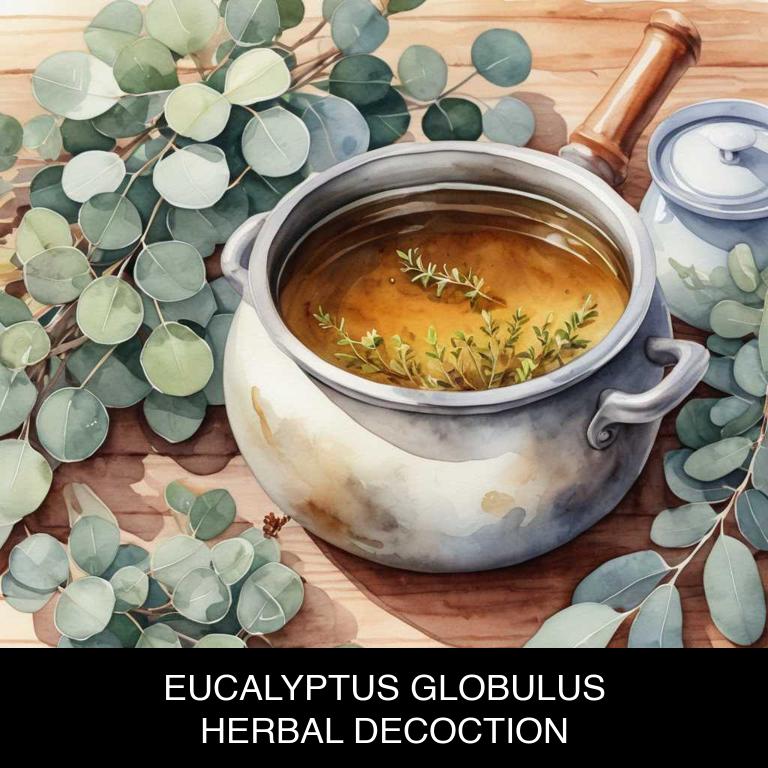
Medicinal Constituents
The list below shows the primary medicinal constituents in Eucalyptus globulus decoctions that help with dry nose.
- Cineole: A primary terpene in Eucalyptus globulus, cineole helps with dry nose by acting as a natural expectorant, loosening mucus and reducing congestion.
- Piperitenone: A phenolic compound found in Eucalyptus globulus, piperitenone has anti-inflammatory properties that may help reduce nasal inflammation and alleviate dryness.
- Α-pinene: A terpene present in Eucalyptus globulus, α-pinene has bronchodilatory effects, which can help widen airways and relieve nasal congestion associated with a dry nose.
Parts Used
The list below shows the primary parts of tasmanian blue gum used to make decoctions for dry nose.
- Leaves: Used for making decoctions to relieve a dry nose due to their high eucalyptol content, which has decongestant properties.
- Barks: Used for making decoctions to relieve a dry nose due to their antiseptic and anti-inflammatory properties.
- Roots: Used for making decoctions to relieve a dry nose due to their antimicrobial properties.
Quick Recipe
The following recipe gives a procedure to make a basic tasmanian blue gum for dry nose.
- Harvest 1/4 cup of eucalyptus globulus leaves from mature plants in the early morning.
- Dry the harvested leaves in a warm dark place for 2-3 days to reduce moisture content.
- Use a mortar and pestle to grind 1 tablespoon of dried eucalyptus globulus leaves into fine powder.
- Steep 1 teaspoon of ground eucalyptus globulus in 1 cup of boiling water for 5-7 minutes to release its properties.
- Strain the decoction using a cheesecloth and discard the solids to obtain a clear liquid solution.
5. Mentha x piperita
Peppermint decoctions helps with dry nose because of its natural expectorant properties, which help to loosen and clear out excess mucus from the nasal passages.
The menthol content in peppermint also provides a soothing and cooling effect on the mucous membranes, reducing inflammation and irritation. This can provide quick relief for individuals experiencing dryness, congestion, and discomfort due to a dry nose.
As the decoction is absorbed into the bloodstream, it can also help to thin out mucus, making it easier to expel and promoting a healthy respiratory system.

Medicinal Constituents
The list below shows the primary medicinal constituents in Mentha x piperita decoctions that help with dry nose.
- Menthol: Menthol acts as a topical anesthetic and vasodilator, helping to increase blood flow and thin mucus, making it easier to breathe and relieving dryness in the nasal passages.
- Royleanone: Royleanone has anti-inflammatory properties, which can help reduce swelling and congestion in the nasal passages, alleviating dryness and discomfort.
- Caryophyllene oxide: Caryophyllene oxide has antimicrobial properties, which can help prevent infections that can exacerbate dryness and discomfort in the nasal passages, promoting a healthier environment for the nose.
Parts Used
The list below shows the primary parts of peppermint used to make decoctions for dry nose.
- Leaves: The leaves are used due to their high menthol content, which helps to thin mucus and relieve congestion.
- Roots: The roots are used for their expectorant properties, helping to loosen and clear mucus from the nasal passages.
- Flowers: The flowers are used for their anti-inflammatory properties, which can help reduce swelling and ease nasal congestion.
Quick Recipe
The following recipe gives a procedure to make a basic peppermint for dry nose.
- Harvest 25g of fresh mentha x piperita leaves and flowers from a clean and pesticide-free area.
- Chop the harvested leaves and flowers into smaller pieces to increase their surface area.
- Combine the chopped mentha x piperita with 1l of boiling water in a heat-resistant container.
- Allow the mixture to steep for 10 minutes to allow the active compounds to infuse.
- Strain the decoction through a cheesecloth or a fine-mesh sieve into a clean container.
6. Thymus vulgaris
Thyme decoctions helps with dry nose because of its natural antiseptic and anti-inflammatory properties.
When brewed into a warm tea, thyme releases compounds that soothe and calm irritated nasal passages, reducing discomfort and congestion caused by dry air. Thyme's decongestant properties also help to loosen and clear out excess mucus, promoting easier breathing and a more comfortable nose.
Regular consumption of thyme decoctions can provide long-lasting relief from the symptoms of a dry nose, making it an effective natural remedy for this common issue.
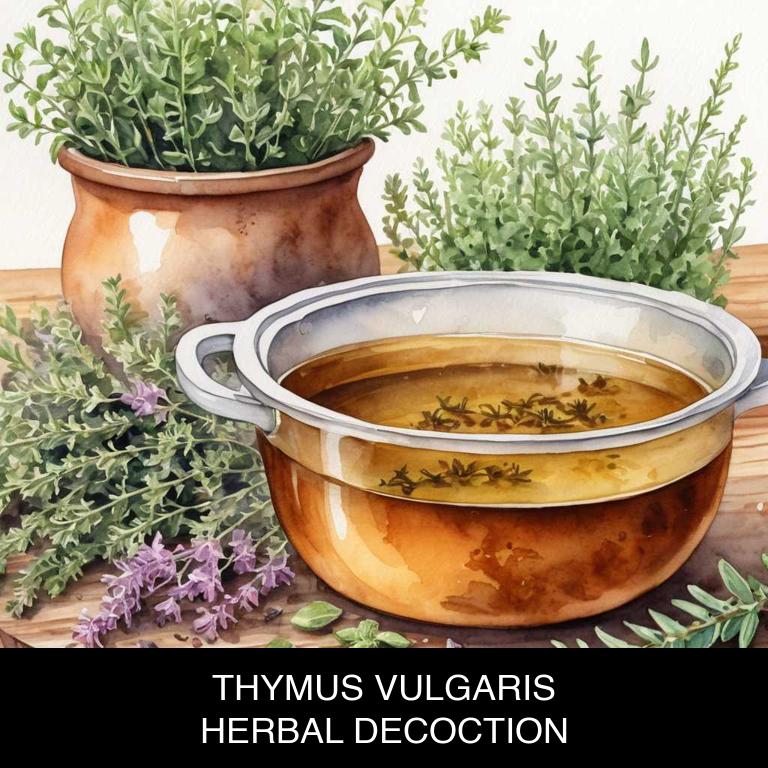
Medicinal Constituents
The list below shows the primary medicinal constituents in Thymus vulgaris decoctions that help with dry nose.
- Thymol: Thymol helps with dry nose by its antimicrobial and anti-inflammatory properties, which reduce swelling and fight off infections that may cause nasal congestion.
- Carvacrol: Carvacrol has decongestant and expectorant properties, helping to break down and clear out mucus that can cause dryness and discomfort in the nose.
- Rosmarinic acid: Rosmarinic acid is a phenolic compound that exhibits anti-inflammatory and antioxidant properties, which help to soothe and calm the nasal passages, reducing inflammation and dryness associated with dry nose.
Parts Used
The list below shows the primary parts of thyme used to make decoctions for dry nose.
- Leaves: Used for their antiseptic and decongestant properties, helping to clear mucus and reduce nasal congestion.
- Stems: Utilized for their expectorant properties, aiding in the removal of mucus and phlegm from the respiratory tract.
- Flowers: Employed for their antiseptic and anti-inflammatory properties, which help soothe and calm the nasal passages.
Quick Recipe
The following recipe gives a procedure to make a basic thyme for dry nose.
- Measure out 2 grams of dried thyme flowers and leaves for a single serving of decoction.
- Combine the measured thyme with 250 milliliters of water in a saucepan.
- Bring the water to a boil then reduce heat to a simmer for 5 to 10 minutes.
- Strain the decoction through a cheesecloth or fine-mesh sieve into a cup.
- Allow the decoction to cool to room temperature before consumption or refrigeration.
7. Lavandula angustifolia
English lavender decoctions helps with dry nose because its antiseptic and anti-inflammatory properties soothe and calm irritated nasal passages, reducing redness and congestion.
The decoction's natural moisturizing effects also help to hydrate the nasal mucosa, providing relief from dryness and itchiness.
Additionally, lavender's calming properties can reduce stress and anxiety, which are often linked to nasal dryness and other respiratory issues, promoting a sense of relaxation and overall well-being.
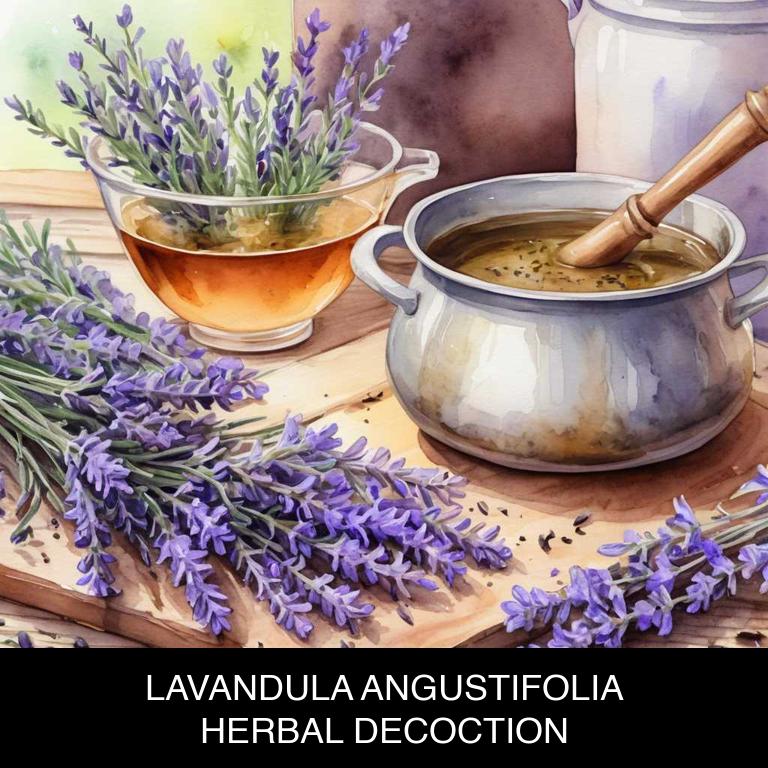
Medicinal Constituents
The list below shows the primary medicinal constituents in Lavandula angustifolia decoctions that help with dry nose.
- Linalool: Linalool, a terpene, has anti-inflammatory properties that help soothe and calm irritated nasal passages, reducing dryness and discomfort.
- Linalyl acetate: Linalyl acetate, another terpene, has decongestant properties that help reduce nasal congestion and promote the drainage of mucus, alleviating dry nose symptoms.
- Caffeic acid: Caffeic acid, a phenolic acid, has antioxidant properties that help protect the nasal mucosa from oxidative stress and inflammation, promoting healthy nasal function and reducing dryness.
Parts Used
The list below shows the primary parts of english lavender used to make decoctions for dry nose.
- Leaves: Used for their decongestant and anti-inflammatory properties to help relieve nasal congestion and dryness.
- Flowers: Employed for their soothing and calming effects to reduce inflammation and promote moisture in the nasal passages.
- Stems: Utilized for their antimicrobial properties to combat infections and promote healing in the nasal tissues.
Quick Recipe
The following recipe gives a procedure to make a basic english lavender for dry nose.
- Gather 25 grams of dried lavandula angustifolia flowers and store them in airtight containers.
- Measure 500 ml of water and heat it to 95 degrees celsius in a saucepan.
- Add the dried flowers to the hot water and let them steep for 5 to 7 minutes.
- Strain the liquid through a cheesecloth or a fine-mesh sieve into a separate container.
- Allow the decoction to cool to room temperature before transferring it to a storage container.
8. Ulmus rubra
Slippery elm decoctions helps with dry nose because it provides a soothing, protective barrier to calm irritated mucous membranes.
The demulcent properties of slippery elm help to lock in moisture, reducing inflammation and discomfort associated with dry nose. By coating the nasal passages with a film-like substance, slippery elm decoctions can also help to trap warm air close to the surface, further increasing moisture levels and promoting healthy mucus production.
This natural remedy offers a gentle and effective way to alleviate symptoms of dry nose, promoting a healthier and more comfortable nasal environment.
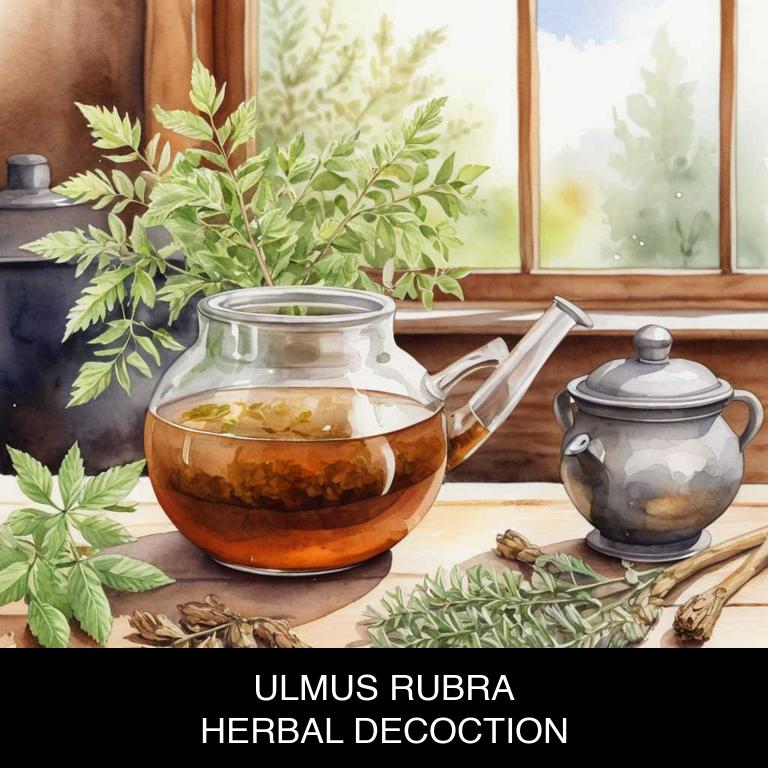
Medicinal Constituents
The list below shows the primary medicinal constituents in Ulmus rubra decoctions that help with dry nose.
- Triterpenoids: These help with dry nose by providing anti-inflammatory and antioxidant properties, which can reduce nasal inflammation and promote healing in the nasal passages.
- Flavonoids: These help with dry nose by acting as antihistamines and ant-inflammatory agents, which can reduce nasal congestion, itching, and dryness associated with allergies and colds.
- Phenolic acids: These help with dry nose by exhibiting antimicrobial and anti-inflammatory properties, which can prevent infections and reduce inflammation in the nasal passages, thereby soothing dryness and discomfort.
Parts Used
The list below shows the primary parts of slippery elm used to make decoctions for dry nose.
- Roots: The roots of Ulmus rubra are commonly used for decoctions due to their ability to promote expectoration and relieve respiratory issues associated with dry nose.
- Leaves: The leaves of the plant are used in decoctions to help soothe and moisturize the nasal passages, providing relief from dryness and congestion.
- Barks: The barks of Ulmus rubra are often used for decoctions to treat respiratory issues and promote healthy mucus production, helping to alleviate dry nose symptoms.
Quick Recipe
The following recipe gives a procedure to make a basic slippery elm for dry nose.
- Gather 2 ounces of dried ulmus rubra bark, 1 ounce of dried leaves, and 1 ounce of dried roots.
- Grind the 2 ounces of dried ulmus rubra bark into a fine powder using a mortar and pestle.
- Combine the ground bark powder, 1 ounce of dried leaves, and 1 ounce of dried roots in a heat-resistant container.
- Steep the mixture in 32 ounces of boiling water for 10 to 15 minutes, then strain the liquid.
- Simmer the strained liquid for an additional 30 minutes to reduce the decoction to 16 ounces.
9. Sambucus nigra
Elder decoctions helps with dry nose because of its exceptional anti-inflammatory properties.
The mucilages present in elder flowers work to soothe and calm irritated nasal passages, reducing inflammation and congestion. Additionally, elder's antiseptic qualities help combat infections that can exacerbate dryness, allowing the nasal membranes to heal and retain their natural moisture balance.
As a result, regular consumption of elder decoctions can provide long-lasting relief from dry, itchy, and congested noses.
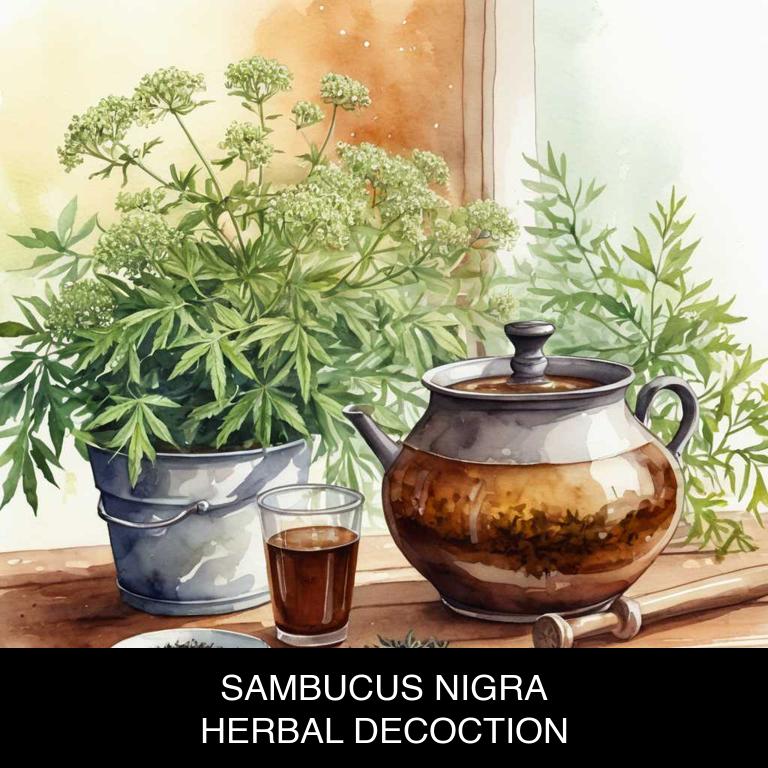
Medicinal Constituents
The list below shows the primary medicinal constituents in Sambucus nigra decoctions that help with dry nose.
- Flavonoids: These plant compounds have potent antioxidant and anti-inflammatory properties, which help reduce nasal inflammation and promote mucous production to alleviate dry nose symptoms.
- Phenylethanol glycosides: These compounds exhibit expectorant properties, facilitating the expulsion of mucus and reducing nasal congestion, which is beneficial for individuals experiencing dry nose.
- Proanthocyanidins: PAs are known for their antioxidant properties and ability to strengthen mucous membranes, which can help alleviate dry nose by maintaining nasal mucosa health and promoting mucous production.
Parts Used
The list below shows the primary parts of elder used to make decoctions for dry nose.
- Flowers: They are used because of their antiseptic and anti-inflammatory properties that help soothe and moisturize the nasal passages.
- Leaves: They are used because they contain flavonoids and terpenoids that have decongestant and anti-inflammatory effects, helping to relieve dry nose symptoms.
- Buds: They are used because they possess antioxidant and anti-inflammatory properties that help reduce swelling and congestion in the nasal passages.
Quick Recipe
The following recipe gives a procedure to make a basic elder for dry nose.
- Harvest 10-20 grams of fresh sambucus nigra flowers and leaves or 5-10 grams of dried material.
- Chop the harvested material into smaller pieces to release the active compounds and essential oils.
- Combine the chopped material with 250ml of boiling water in a saucepan to create a decoction base.
- Reduce heat to a simmer and let the decoction steep for 10-15 minutes to allow the active compounds to infuse.
- Strain the decoction through a cheesecloth or fine-mesh sieve into a clean container and discard the solids.
10. Ginkgo biloba
Maidenhair tree decoctions helps with dry nose because of its rich antioxidant and anti-inflammatory properties.
The decoction's mucilage content helps to soothe and moisturize the nasal passages, reducing irritation and congestion. Additionally, its expectorant properties aid in loosening and clearing out mucus, making it easier to breathe and relieving dryness and discomfort.
By using maidenhair tree decoctions regularly, individuals can experience relief from dry nose symptoms and enjoy improved respiratory health.

Medicinal Constituents
The list below shows the primary medicinal constituents in Ginkgo biloba decoctions that help with dry nose.
- Flavonoids: These compounds help alleviate dry nose by reducing inflammation and improving blood circulation to the nasal mucosa, promoting healthy nasal function.
- Bilobalide: Bilobalide is an sesquiterpene lactone that helps to reduce inflammation and oxidative stress in the nasal passages, thereby alleviating dryness and discomfort.
- Quercetin: This flavonoid acts as an anti-inflammatory agent, reducing swelling and irritation in the nasal mucosa, and also exhibits antioxidant properties that help protect the nasal lining from damage caused by free radicals.
Parts Used
The list below shows the primary parts of maidenhair tree used to make decoctions for dry nose.
- Leaves: Used due to their rich content of flavonoids and terpenoids, which have anti-inflammatory and decongestant properties.
- Buds: Utilized for their high flavonoid content, which helps to reduce inflammation and promote mucous production, alleviating dry nose symptoms.
- Seeds: Employed due to their unique fatty acid composition, which may help to moisturize and soothe the nasal passages.
Quick Recipe
The following recipe gives a procedure to make a basic maidenhair tree for dry nose.
- Measure 250 milliliters of boiling water into a heat-resistant glass container to prepare for infusion.
- Add one gram of dried ginkgo biloba leaves to the boiling water and let steep for ten minutes.
- Strain the liquid through a cheesecloth or a fine-mesh sieve into another container to remove solids.
- Store the decoction in the refrigerator for up to two days in a glass container with a tight-fitting lid.
- Consume the decoction in 50 milliliter doses two to three times a day after meals as needed.
What is the best combination of herbal decoctions to use for dry nose?
The best combination of herbal decoctions that help with dry nose is a blend of Echinacea, Marshmallow, and Thyme.
Echinacea boosts the immune system to fight off underlying infections, while Marshmallow soothes and moisturizes the nasal passages. Thyme, rich in antiseptic properties, helps to kill bacteria and reduce inflammation.
This trio of herbs can be brewed together and consumed as a warm tea to provide relief from dry, itchy, and irritated nasal passages, promoting healthy nasal function and comfort.
What ailments similar to dry nose are treated with herbal decoctions?
Ailments similar to dry nose that are treated with herbal decoctions are various respiratory and sinus issues.
Conditions such as bronchitis, asthma, and chronic coughs can be alleviated with the use of herbal decoctions like thyme, eucalyptus, and ginger. Herbal decoctions can also help to soothe sore throats and relieve symptoms of tonsillitis and pharyngitis.
Additionally, decoctions made from herbs like peppermint and chamomile can provide relief from headaches and sinus congestion.